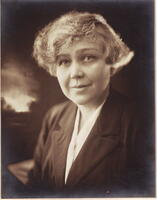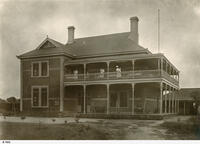
South Australian Medical Heritage Society Inc
Website for the Virtual Museum
Home
Coming meetings
Past meetings
About the Society
Main Galleries
Medicine
Surgery
Anaesthesia
X-rays
Hospitals,other
organisations
Individuals of
note
Small Galleries
Ethnic medicine
- Aboriginal
- Chinese
- Mediterran
Helen Mary Mayo OBE, MBBS, MD [1878-1967]
Medical Practitioner & Promoter of Child Health Services
ACKNOWLEDGEMENTS
We are most grateful to Kay Clapton, on behalf of the Yesteryear Group of the Oaklands VIEW club, for allowing us to present this article.
Heleni was the eldest of six children born to Henrietta and her civil engineer husband George Gibbes Mayo. She was also the granddaughter of well-known Doctor George Mayo and his wife Maria Gandy who had nursed Colonel William Light during his final illness.ii
It was a happy household only marred by the tragic death of her younger sister Olive, aged 13½ years.iii Her brothers would also go on to have distinguished careers: Elton as a world-renowned psychologist, Herbert as a SA judge and John as a radiologist treating cancer. Her sister Penelope wrote The Life and Letters of Colonel William Light.iv
Helen excelled at the University of Adelaide and topped her final year of Medicine which won her the Everard Scholarship of £50.v She was the only female of the five resident medical officers appointed to the Adelaide Hospital in 1902.vi To gain wider experience, in 1904 Helen went to London where she worked as a clinical clerk at the Hospital for Sick Children. She followed this with a midwifery stint at Dublin's Coombe Women's Hospital before returning to London to complete a tropical medicine course. From there she moved to Delhi's St Stephen's Hospital for Women and Children where she noticed a higher incidence of caesarean births among women in purdah (seclusion of women from public observation). Many had rickets, although the connection with vitamin D deficiency was unknown then. Helen also commented wryly that she was admired in India where fat was a valued quality. She was known to joke about her weight and unruly hair.vii
Helen returned to Adelaide in 1906 and set up a private practice in Morphett Street. She was appointed honorary anaesthetist at the Adelaide Children's Hospital and clinical bacteriologist at Adelaide Hospital. In 1909 Helen presented a paper at an interstate conference where she compared the 1907 infant mortality rates in various regions: SA 65.6 per 1000 (the lowest in more than 20 years), WA 97.7, NZ 88.9, NSW 88.6, Qld 77.2, Tasmania 83, Victoria 72.6 [nationally in 2020: 2.9 per thousand]. She identified the contributory causes as: ignorance of parents about natural food, regularity of feeding, need for abundant clean fresh air, cleanliness and warmth; storage of milk, particularly in summer to avoid diarrhoea; unsuitable foods; and poor ventilation in homes causing respiratory problems. She recommended that notifications of birth should reach the medical officer within 48 hours with lady assistant medical officers of health to visit the homes to enquire, advise and help.viii
In 1909 Harriet Stirling and Helen joined forces to establish the School for Mothers where mothers could bring their babies one afternoon a week to be weighed by a nurse with Helen and Harriet providing health advice. In 1911 a cottage in Wright Street was purchased and became the school headquarters.
Helen visited Melbourne in 1911 to learn how to make vaccines and was appointed clinical bacteriologist at the Adelaide Hospital, a position she held for 22 years. During the 1910's there was an urgent need for medical facilities to treat infants under two years as they were excluded from the Adelaide Children's Hospital due to the risks of cross-infection. Helen and Harriet called on medical practitioners to lobby for a separate ward on the grounds of the hospital. The board rejected the proposal, so Helen and her group rented a house as a hospital for infants, although over the three years it experienced financial difficulties. In 1917 the state government took over the hospital, moved it to Woodville and named it the Mareeba Hospital. Helen acted in an honorary capacity as physician and responsible officer (1921-1946). To combat the risk of cross-infection she instituted a policy of strict isolation of ill babies from other patients. The hospital became a 70-bed hospital, complete with surgical unit and a ward for premature babies.ix
With positions at the Royal Adelaide Hospital, Children's Hospital and the Mareeba Hospital Helen wrote her thesis on the weekends and was the first woman to receive an MD from the University of Adelaide in 1926. The School for Mothers became the Mothers and Babies' Health Association (MBHA) and by 1932 it was a state-wide organisation with 46 health centres, 20 triple-certificated nurse and a baby health train which went to country areas.x 1937 saw the MBHA introduce mothercraft lectures and demonstrations to school girls.xi In 1935 Helen was awarded an OBE for her work with mothers and babies. She came out of retirement to work as a Senior Paediatric Advisor at the Adelaide Children's Hospital and organised the Red Cross donor transfusion service during the war years. Helen did not marry and from 1931 lived in a house in Brougham Place, North Adelaide purchased with her long-term partner Dr Constance Finlayson.
Member of the British Medical Association from 1905. One of the founders of the Women Graduates' Club of the University of Adelaide in 1909. Elected to the University of Adelaide Council (governing body of the university) in 1914 and held this position until 1960. In 1922 helped found the Lyceum Club to advance the status of women in professional life, art and letters. Foundation Fellow of the Royal Australasian College of Physicians from 1933. Founder member of the committee formed in 1939 to establish St Ann's College & Chairman until 1959.
References
- Photo taken in about 1914, University of Adelaide Archives
- https://en.wikipedia.org/wiki/William_Light#Later_life,_death_and_burial
- Trove: South Australian Register (Adelaide, SA: 1839-1900) Funeral Notices, Friday 20 Nov 1896, page 2
- State Library of South Australia, PRG 127 Series List – Mayo Family Papers
- Hodder, Edwin: The History of South Australia Volume II, published by Good Press 2021
- Trove: Advertiser (Adelaide, SA: 1889-1931) The Adelaide Hospital, Thursday 25 December 1902, page 4
- https://loststory.net/australianwomen/helen-mayo"
- Trove: Observer (Adelaide, SA: 1905-1931) Infant Mortality – Contributory Causes, Saturday 22 May 1909, page 40
- Photo taken in 1921, State Library of South Australia Mareeba Hospital, Woodville Park [B 1802]
- Trove: News (Adelaide, SA: 1923-1954) Safeguarding Baby’s Health, Tuesday 4 October 1932, page 4
- Trove: News (Adelaide, SA: 1923-1954 How to Care for Babies – Girls Taught at School, Thursday 5 May 1938, page 18

